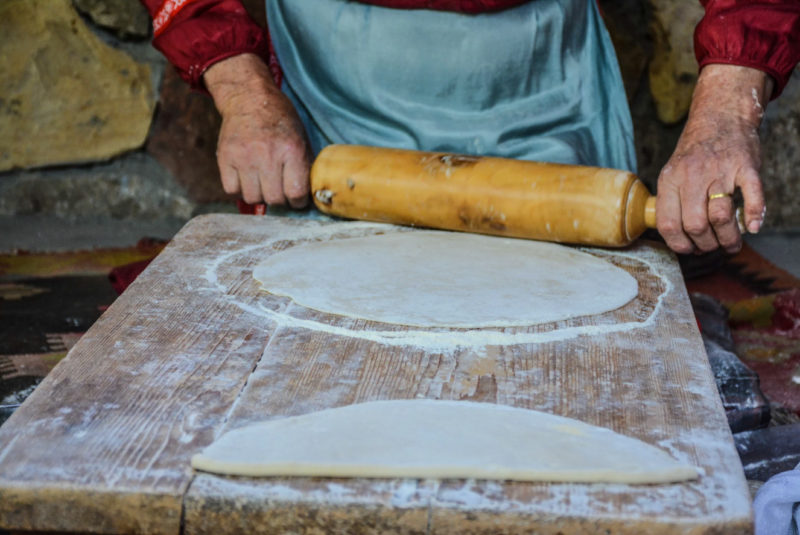[:it]Il Lavash, il sottile pane tradizionale armeno è stato iscritto dall’Unesco nel Patrimonio culturale immateriale dell’Umanità. Rispecchia l’anima del Paese e di un popolo che ha sempre mantenuto vive ed intatte le proprie tradizioni.
A tavola non manca mai, servito in cestini intrecciati, è considerato il simbolo della famiglia, infatti svolge anche un ruolo rituale nei matrimoni, dove viene posto sulle spalle degli sposi per portare fertilità e prosperità.
La sua preparazione rafforza i legami familiari, comunitari e sociali. Il processo è intrapreso da un piccolo gruppo di donne e richiede un grande sforzo, coordinazione, esperienza e abilità speciali. Si prepara un semplice impasto a base di farina di grano e acqua, un pizzico di sale e senza lievito, viene lavorato e composto in palline. Una per volta, le palline vengono lavorate in sfoglie sottili con un mattarello e allargate facendole volteggiare con le mani, quindi stese su uno speciale cuscino ovale che viene “schiaffeggiato” contro il muro di un tradizionale forno conico in argilla, il tonir, rivestito di pietra o di ceramica, scavato nella terra. Dopo trenta secondi il pane cotto viene estratto dalla parete del forno.
Più che alla preparazione di un alimento sembra di assistere a un rito ancestrale, dove ammirare la maestria dei movimenti rapidi e decisi, frutto di un’esperienza acquisita giorno dopo giorno, tramandata di generazione in generazione.
Non solo donne comunque nella fase di preparazione: gli uomini sono coinvolti ancor prima nella creazione dei cuscini e dei forni, con l’impegno di trasmettere la loro abilità a studenti e apprendisti come passo necessario per preservare la vitalità della produzione del lavash.
In genere viene abbinato ai formaggi locali, alle erbe aromatiche come il basilico, coriandolo, prezzemolo e menta. E’ meglio mangiarlo appena sfornato, ma può essere conservato fino a 6 mesi in fogli essiccati e impilati uno sull’altro.
Mangiando il Lavash si ritrova nel suo sapore la storia di un passato mai dimenticato, un’essenza che nel corso dei millenni è rimasta intatta fino ad arrivare sulle tavole di oggi.[:en]Lavash, the thin Armenian traditional bread has been inscribed by UNESCO in the Intangible Cultural Heritage of Humanity. It reflects the soul of the country and of a people who have always kept their traditions alive and intact.
At the table it never fails, served in woven baskets, it is considered the symbol of the family, in fact it also plays a ritual role in weddings, where it is placed on the shoulders of the spouses to bring fertility and prosperity.
Its preparation strengthens family, community and social ties. The process is undertaken by a small group of women and requires a great deal of effort, coordination, experience and special skills. A simple dough made from wheat flour and water is prepared, a pinch of salt and without yeast, is worked and composed into balls. One at a time, the balls are worked into thin sheets with a rolling pin and enlarged making them twirl with their hands, then spread on a special oval cushion which is “slapped” against the wall of a traditional conical clay oven, the tonir, coated with stone or ceramic, excavated in the earth. After thirty seconds the baked bread is extracted from the oven wall.
More than preparing a food, it seems to witness an ancestral ritual, where you can admire the mastery of rapid and decisive movements, the result of an experience acquired day after day, handed down from generation to generation.
Not only women, however, in the preparation phase: men are involved even earlier in the creation of cushions and ovens, with the commitment to transmit their skills to students and apprentices as a necessary step to preserve the vitality of lavash production.
It is generally combined with local cheeses, aromatic herbs such as basil, coriander, parsley and mint. It is better to eat it fresh from the oven, but it can be stored for up to 6 months in dried sheets and stacked on top of each other.
By eating Lavash, the flavor of a never forgotten past is found in its flavor, an essence that has remained intact over the millennia until it reaches today’s tables.[:]






